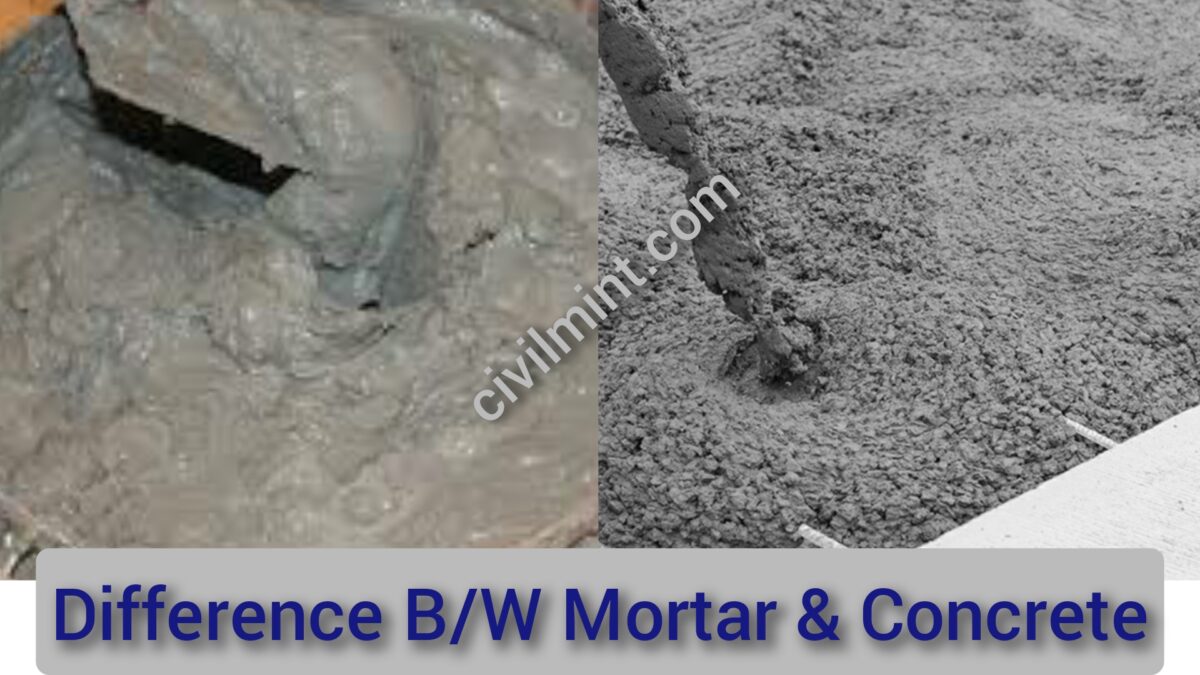Mortar is a combination of sand and concretes that is most frequently used to construct brick or block walls. While that might seem like a similar formula used to make concrete, there are a few purposeful contrasts between the formulations for mortar and concrete, which is the reason the materials should not be used interchangeably.

Assuming Portland concrete cement is one of the most generally involved building materials on the planet, masonry mortar is not far behind. Like concrete, mortar is likewise intended to be strong however accomplishes its objective through finesse. Its assets are very low contrasted with concrete and it is never utilized in thick applications. It is a lot creamier and more serviceable than concrete.
Table of Contents
Difference Between Mortar And Concrete
Here is a detailed table outlining key differences between mortar and concrete:
| # | Mortar | Concrete |
|---|---|---|
| 1 | Mortar is a mixture of cement, sand, and water in a specific proportion. | Concrete is a mixture of cement, sand, gravel or crushed stone, and water in a specific proportion. |
| 2 | Mortar is used as a binding material between bricks, blocks, and other masonry units. | Concrete is used for constructing slabs, columns, beams, foundations, and walls. |
| 3 | Mortar is typically weaker and less durable than concrete. | Concrete is stronger and more durable than mortar. |
| 4 | The proportion of cement in mortar is usually higher than that in concrete. | The proportion of cement in concrete is usually lower than that in mortar. |
| 5 | Mortar is typically used in thin layers. | Concrete can be used in thick or thin layers. |
| 6 | Mortar is usually applied by hand using a trowel. | Concrete can be applied by hand or with a pump. |
| 7 | Mortar is typically used for smaller, more intricate masonry projects. | Concrete is typically used for larger, more structural projects. |
| 8 | Mortar is not suitable for load-bearing structures. | Concrete is suitable for load-bearing structures. |
| 9 | Mortar has a lower compressive strength than concrete. | Concrete has a higher compressive strength than mortar. |
| 10 | Mortar has a lower tensile strength than concrete. | Concrete has a higher tensile strength than mortar. |
| 11 | Mortar is more porous than concrete. | Concrete is less porous than mortar. |
| 12 | Mortar is more flexible than concrete. | Concrete is less flexible than mortar. |
| 13 | Mortar is more adhesive than concrete. | Concrete is less adhesive than mortar. |
| 14 | Mortar has a smoother surface finish than concrete. | Concrete has a rougher surface finish than mortar. |
| 15 | Mortar sets more quickly than concrete. | Concrete takes longer to set than mortar. |
| 16 | Mortar is usually gray or white in color. | Concrete can be colored using pigments. |
| 17 | Mortar is easier to work with than concrete. | Concrete can be more challenging to work with due to its thickness and weight. |
| 18 | Mortar is more affordable than concrete. | Concrete can be more expensive than mortar. |
| 19 | Mortar is more environmentally friendly than concrete. | Concrete can have a higher carbon footprint than mortar. |
| 20 | Mortar is easier to clean than concrete. | Concrete can be more challenging to clean due to its rough surface finish. |
| 21 | Mortar has a lower thermal conductivity than concrete. | Concrete has a higher thermal conductivity than mortar. |
| 22 | Mortar is not suitable for high-stress applications. | Concrete is suitable for high-stress applications. |
| 23 | Mortar is not ideal for exterior use. | Concrete is suitable for exterior use. |
| 24 | Mortar is used for repairs and small patching jobs. | Concrete is used for larger repair jobs. |
| 25 | Mortar can be used for decorative purposes, such as creating patterns in brickwork. | Concrete is less suitable for decorative work. |
| Mortar is not as resistant to weathering as concrete. | Concrete is more resistant to weathering than mortar. | |
| 27. | Mortar is used for laying tiles and fixing ceramic surfaces. | Concrete is not suitable for laying tiles or fixing ceramic surfaces. |
| 28. | Mortar is typically mixed in small batches. | Concrete can be mixed in large batches using a concrete mixer. |
| 29. | Mortar is less dense than concrete. | Concrete is denser than mortar. |
| 30. | Mortar is used for jointing, pointing, and plastering. | Concrete is not typically used for jointing, pointing, or plastering. |
Mortar Vs Concrete
- Concrete is a mixture of cement, sand, water, and aggregate while Mortar is a mixture of cement, sand, and water.
- Water-cement ratio is low in mortar compare to concrete.
- Concrete is used for beam, column, slab, and other structural members to cast these structures while the mortar is used for plastering, masonry work.
- Concrete has very high strength compared to mortar.
- Concrete used with or without reinforcement while mortar can not be used with reinforcement.
- Concrete is more durable than mortar.
- Concrete does not work as a bonding element while mortar works as a bonding agent.
Conclusion
Mortar and concrete have distinct differences in terms of their composition, properties, and uses. Knowing these differences is important when deciding which material to use for a specific project.
From the above differences between mortar and concrete, you can understand that both elements have different characteristics and are used for different purposes.
